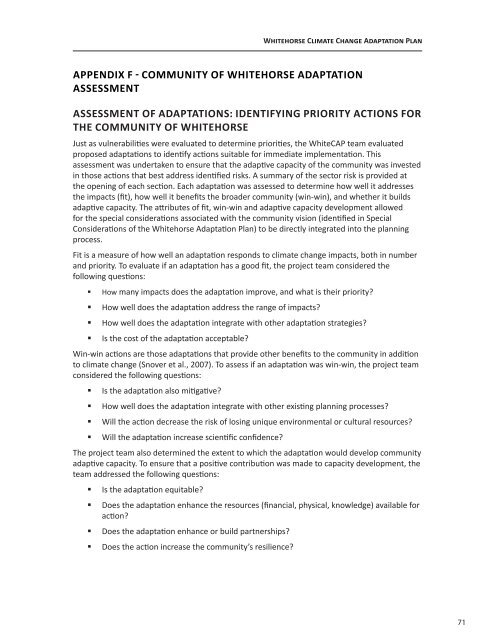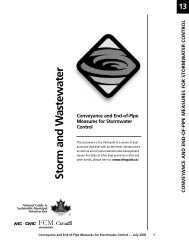Whitehorse Climate Change Adaptation Plan - Yukon College
Whitehorse Climate Change Adaptation Plan - Yukon College
Whitehorse Climate Change Adaptation Plan - Yukon College
You also want an ePaper? Increase the reach of your titles
YUMPU automatically turns print PDFs into web optimized ePapers that Google loves.
APPENDIX F - COMMUNITY OF WHITEHORSE ADAPTATION<br />
ASSESSMENT<br />
ASSESSMENT OF ADAPTATIONS: IDENTIFYING PRIORITY ACTIONS FOR<br />
THE COMMUNITY OF WHITEHORSE<br />
Just as vulnerabilities were evaluated to determine priorities, the WhiteCAP team evaluated<br />
proposed adaptations to identify actions suitable for immediate implementation. This<br />
assessment was undertaken to ensure that the adaptive capacity of the community was invested<br />
in those actions that best address identified risks. A summary of the sector risk is provided at<br />
the opening of each section. Each adaptation was assessed to determine how well it addresses<br />
the impacts (fit), how well it benefits the broader community (win-win), and whether it builds<br />
adaptive capacity. The attributes of fit, win-win and adaptive capacity development allowed<br />
for the special considerations associated with the community vision (identified in Special<br />
Considerations of the <strong>Whitehorse</strong> <strong>Adaptation</strong> <strong>Plan</strong>) to be directly integrated into the planning<br />
process.<br />
Fit is a measure of how well an adaptation responds to climate change impacts, both in number<br />
and priority. To evaluate if an adaptation has a good fit, the project team considered the<br />
following questions:<br />
How many impacts does the adaptation improve, and what is their priority?<br />
How well does the adaptation address the range of impacts?<br />
How well does the adaptation integrate with other adaptation strategies?<br />
Is the cost of the adaptation acceptable?<br />
Win-win actions are those adaptations that provide other benefits to the community in addition<br />
to climate change (Snover et al., 2007). To assess if an adaptation was win-win, the project team<br />
considered the following questions:<br />
Is the adaptation also mitigative?<br />
How well does the adaptation integrate with other existing planning processes?<br />
Will the action decrease the risk of losing unique environmental or cultural resources?<br />
Will the adaptation increase scientific confidence?<br />
The project team also determined the extent to which the adaptation would develop community<br />
adaptive capacity. To ensure that a positive contribution was made to capacity development, the<br />
team addressed the following questions:<br />
Is the adaptation equitable?<br />
Does the adaptation enhance the resources (financial, physical, knowledge) available for<br />
action?<br />
Does the adaptation enhance or build partnerships?<br />
Does the action increase the community’s resilience?<br />
<strong>Whitehorse</strong> <strong>Climate</strong> <strong>Change</strong> <strong>Adaptation</strong> <strong>Plan</strong><br />
71

















